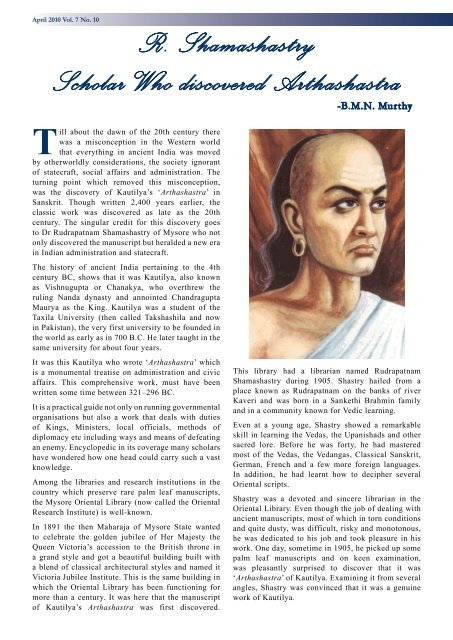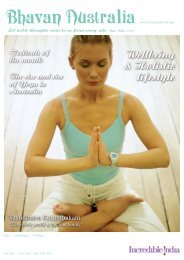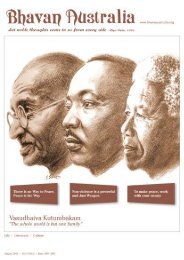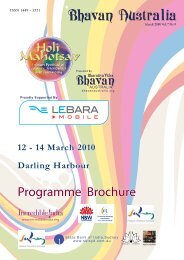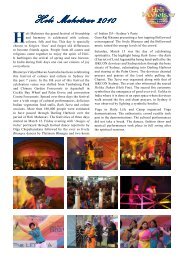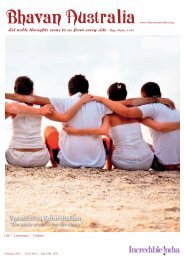'The whole world is but one family' - Bharatiya Vidya Bhavan Australia
'The whole world is but one family' - Bharatiya Vidya Bhavan Australia
'The whole world is but one family' - Bharatiya Vidya Bhavan Australia
You also want an ePaper? Increase the reach of your titles
YUMPU automatically turns print PDFs into web optimized ePapers that Google loves.
April 2010 Vol. 7 No. 10<br />
R. Shamashastry<br />
Scholar Who d<strong>is</strong>covered Arthashastra<br />
Till about the dawn of the 20th century there<br />
was a m<strong>is</strong>conception in the Western <strong>world</strong><br />
that everything in ancient India was moved<br />
by other<strong>world</strong>ly considerations, the society ignorant<br />
of statecraft, social affairs and admin<strong>is</strong>tration. The<br />
turning point which removed th<strong>is</strong> m<strong>is</strong>conception,<br />
was the d<strong>is</strong>covery of Kautilya’s ‘Arthashastra’ in<br />
Sanskrit. Though written 2,400 years earlier, the<br />
classic work was d<strong>is</strong>covered as late as the 20th<br />
century. The singular credit for th<strong>is</strong> d<strong>is</strong>covery goes<br />
to Dr Rudrapatnam Shamashastry of Mysore who not<br />
only d<strong>is</strong>covered the manuscript <strong>but</strong> heralded a new era<br />
in Indian admin<strong>is</strong>tration and statecraft.<br />
The h<strong>is</strong>tory of ancient India pertaining to the 4th<br />
century BC, shows that it was Kautilya, also known<br />
as V<strong>is</strong>hnugupta or Chanakya, who overthrew the<br />
ruling Nanda dynasty and annointed Chandragupta<br />
Maurya as the King. Kautilya was a student of the<br />
Taxila University (then called Takshashila and now<br />
in Pak<strong>is</strong>tan), the very first university to be founded in<br />
the <strong>world</strong> as early as in 700 B.C. He later taught in the<br />
same university for about four years.<br />
It was th<strong>is</strong> Kautilya who wrote ‘Arthashastra’ which<br />
<strong>is</strong> a monumental treat<strong>is</strong>e on admin<strong>is</strong>tration and civic<br />
affairs. Th<strong>is</strong> comprehensive work, must have been<br />
written some time between 321–296 BC.<br />
It <strong>is</strong> a practical guide not only on running governmental<br />
organ<strong>is</strong>ations <strong>but</strong> also a work that deals with duties<br />
of Kings, Min<strong>is</strong>ters, local officials, methods of<br />
diplomacy etc including ways and means of defeating<br />
an enemy. Encyclopedic in its coverage many scholars<br />
have wondered how <strong>one</strong> head could carry such a vast<br />
knowledge.<br />
Among the libraries and research institutions in the<br />
country which preserve rare palm leaf manuscripts,<br />
the Mysore Oriental Library (now called the Oriental<br />
Research Institute) <strong>is</strong> well-known.<br />
In 1891 the then Maharaja of Mysore State wanted<br />
to celebrate the golden jubilee of Her Majesty the<br />
Queen Victoria’s accession to the Brit<strong>is</strong>h thr<strong>one</strong> in<br />
a grand style and got a beautiful building built with<br />
a blend of classical architectural styles and named it<br />
Victoria Jubilee Institute. Th<strong>is</strong> <strong>is</strong> the same building in<br />
which the Oriental Library has been functioning for<br />
more than a century. It was here that the manuscript<br />
of Kautilya’s Arthashastra was first d<strong>is</strong>covered.<br />
-B.M.N. Murthy<br />
Th<strong>is</strong> library had a librarian named Rudrapatnam<br />
Shamashastry during 1905. Shastry hailed from a<br />
place known as Rudrapatnam on the banks of river<br />
Kaveri and was born in a Sankethi Brahmin family<br />
and in a community known for Vedic learning.<br />
Even at a young age, Shastry showed a remarkable<br />
skill in learning the Vedas, the Upan<strong>is</strong>hads and other<br />
sacred lore. Before he was forty, he had mastered<br />
most of the Vedas, the Vedangas, Classical Sanskrit,<br />
German, French and a few more foreign languages.<br />
In addition, he had learnt how to decipher several<br />
Oriental scripts.<br />
Shastry was a devoted and sincere librarian in the<br />
Oriental Library. Even though the job of dealing with<br />
ancient manuscripts, most of which in torn conditions<br />
and quite dusty, was difficult, r<strong>is</strong>ky and monotonous,<br />
he was dedicated to h<strong>is</strong> job and took pleasure in h<strong>is</strong><br />
work. One day, sometime in 1905, he picked up some<br />
palm leaf manuscripts and on keen examination,<br />
was pleasantly surpr<strong>is</strong>ed to d<strong>is</strong>cover that it was<br />
‘Arthashastra’ of Kautilya. Examining it from several<br />
angles, Shastry was convinced that it was a genuine<br />
work of Kautilya.


